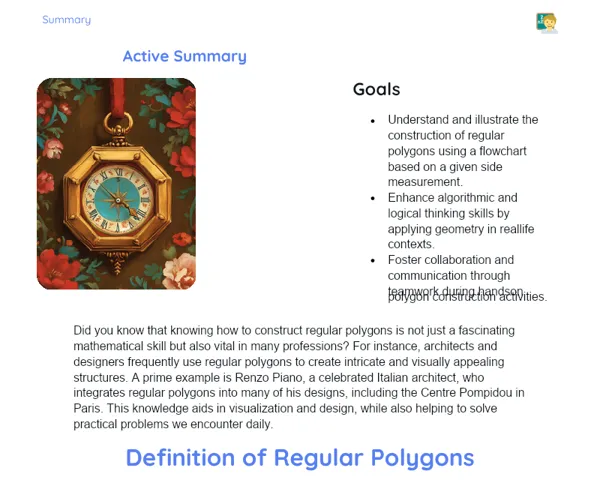Socioemotional Summary Conclusion
Goals
1. Calculate the area of triangles using the formula: area equals base times height divided by two.
2. Recognize and understand the emotions that come with learning new mathematical concepts.
3. Encourage effective communication and appropriate expression of emotions during mathematical problem-solving.
Contextualization
Did you know that the formula for finding the area of a triangle can be applied in a range of day-to-day situations? For instance, if you’re helping to paint a triangular wall in your home, knowing how to calculate the area is crucial! Additionally, mathematics fosters logical and structured thinking, which is vital for tackling problems and making informed decisions. Let's dive in together to see how this fantastic formula can simplify our lives! 🚀📐
Exercising Your Knowledge
Definition of Triangle
A triangle is a polygon with three sides. It can be classified into different types based on the measurement of its sides and angles, like equilateral (all sides equal), isosceles (two sides equal), and scalene (all sides different). Understanding these types helps us apply the area formula accurately across various contexts.
-
Types of Triangles: Equilateral triangles have all sides equal, isosceles triangles have two sides equal, and scalene triangles have all sides different. Recognizing these types simplifies the application of the area formula.
-
Importance of Angles: The sum of the internal angles of any triangle is always 180 degrees. This fundamental understanding aids in solving more complex problems and comprehending geometry in various fields.
Components of the Triangle
Each triangle consists of three sides, three vertices, and three angles. The relation between these components is key to understanding how to calculate the area and solve geometry problems. The base and height are particularly crucial when utilizing the area formula.
-
Sides and Vertices: Identifying the sides and vertices of a triangle is critical for any geometric calculation. This visualization improves the accuracy of problem-solving.
-
Base and Height: The base of a triangle can be one of its sides, and the height is the perpendicular extending from the vertex opposite to the base. Grasping this relationship is essential for applying the area formula effectively.
Area Formula
The formula for calculating the area of a triangle is: Area = (base * height) / 2. This formula is universally applicable to any type of triangle, making it a powerful tool for solving mathematical problems.
-
Universal Application: The area formula can be used for any triangle, irrespective of type, making it extremely versatile.
-
Practical Examples: For instance, for a triangle with a base of 8 cm and a height of 5 cm, the area would be: Area = (8 * 5) / 2 = 20 cm². Real-world examples help with visualizing and comprehending the concept better.
Key Terms
-
Triangle: A polygon with three sides.
-
Equilateral: A triangle where all sides are equal.
-
Isosceles: A triangle with two sides equal.
-
Scalene: A triangle with all sides different.
-
Base: Any one of the sides of a triangle.
-
Height: The perpendicular drawn from the vertex opposite to the base.
-
Area: The space enclosed within a geometric figure, calculated for triangles as (base * height) / 2.
For Reflection
-
How did you feel while learning the triangle area formula? Was there a moment of frustration or joy? Describe your feelings and how you handled them.
-
In what ways do you think calculating the area of triangles can be handy in your daily life? Reflect on practical instances where this knowledge could come into play.
-
How did collaborating with your classmates in class assist or challenge your learning? What emotions arose during these interactions, and how did you express them?
Important Conclusions
-
We learnt how to calculate the area of triangles using the formula: area equals base times height divided by two.
-
We recognized the importance of acknowledging and managing our emotions while grappling with new mathematical concepts.
-
We practiced effective communication and the appropriate expression of emotions while solving mathematics problems, which enhanced our collaboration and empathy.
Impacts on Society
Calculating the area of triangles is a practical skill with numerous applications in daily life. For example, when planning a garden or decorating a room, knowing the area helps in estimating materials like grass, paint, or flooring. Furthermore, this skill is essential in professions such as engineering, architecture, and design, where precise geometric calculations significantly affect the quality of work.
From an emotional perspective, learning to calculate the area of triangles nurtures a problem-solving mindset. Navigating frustrations and celebrating small victories while applying the formula teaches us resilience. This learning can be applied to other aspects of life, reinforcing the notion that with focus and patience, we can overcome challenges and achieve our goals.
Dealing with Emotions
To assist you in managing your emotions while learning about the area of triangles, I suggest an exercise based on the RULER method. First, identify how you feel when encountering a challenging math problem. It might be frustration, anxiety, or even excitement. Next, try to comprehend why those emotions surface: Is it due to the difficulty of the problem? The pressure to succeed? Accurately label those emotions, telling yourself: 'I am frustrated because I can't grasp the formula.' Then, express those emotions appropriately by discussing them with a friend or jotting them down in a journal. Finally, regulate those feelings by taking deep breaths, allowing yourself a short break, or seeking help. 💪🗒️
Study Tips
-
Practice regularly with various types of triangles to become comfortable applying the formula in diverse scenarios.
-
Form study groups to discuss and tackle problems together. Collaborating can help share strategies and deepen understanding of concepts.
-
Take advantage of online resources, such as videos and educational games, to make learning more dynamic and enjoyable. 📹🎮



